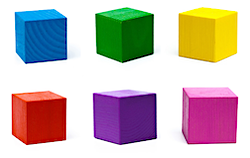Number Sense Builds a Strong Math Foundation
By Kathleen Palmieri

Thanks to my research, I was able to develop many math vocabulary strategies and experienced great success with my fifth graders.
It wasn’t too long before I found myself once again jumping back into research mode. Over the past few years – due at least in part to the pandemic’s effects – we’ve seen a decrease in students’ math fact recall and their ability to manage their working memory when it comes to manipulating numbers.
My latest research led me to the work of Jo Boaler, Stanford University Professor of Mathematics Education, co-founder of youcubed, and author. Years ago, educators used “Mad Minutes” to time students to determine how fluent they were with a particular multiple or operation. I learned from Boaler’s paper Fluency Without Fear: Research Evidence on the Best Ways to Learn Math Facts that:
“Mathematics facts are important but the memorization of math facts through times table repetition practice and timed testing is unnecessary and damaging…. Math facts, themselves, are a small part of mathematics and they are best learned through the use of numbers in different ways and situations.” (page 1)
A discussion in the Cambridge Mathematics Express (Issue 4, February 2017) states that “Number sense is not a term that all researchers define in exactly the same way, but includes counting and comparing skills and the flexible ability to compute and represent numbers. It can be improved through teaching.”
Number sense – making sense of numbers – is the foundation for higher conceptual understanding and mathematical knowledge and relies on the links between number relationships, operations, and processes.
So how does this look in the math classroom?
The first thing I tell my students is that there is always more than one way to solve a math problem. It is important that students understand the many ways numbers can be logically manipulated in different ways yet result in the same correct answer.
Solving is less about using a certain procedure and more about the skill in thinking about numbers, along with the learning of operations and concepts that must occur in order to help develop mathematical reasoning strategies. If a student does not understand the concept or procedure, the probability of error is high and their confidence level generally plummets.
The National Council of Teachers of Mathematics Procedural Fluency: Reasoning and Decision Making, Not Rote Application of Procedures Position (January, 2023) offers declarations that “describe necessary actions to ensure that every student has access to and develops procedural fluency.” These declarations are:
►1. Conceptual understanding must precede and coincide with instruction on procedure. Explicit teaching of the procedures connects logically with students. If students do not understand what they are doing, errors occur and there is no understanding of why they occurred.
►2. Procedural fluency requires having a repertoire of strategies. I tell my students when I introduce a new procedure that it is a tool for their math toolbox in their mind.
►3. Basic facts should be taught using number relationships and reasoning strategies, not memorization. A great deal of data supports this claim: Students who learn fact strategies outperform students who learn through other approaches (e.g. Baroody et al 2016; Henry and Brown 2008; Brendefur et al. 2015). Basic fact strategies use number relationships and benchmarks and thus support students emerging conceptual understanding and flexibility (Bay-Williams and Kling 2019; Davenport et al. 2019). Strategies such as Making 10 build a foundation for strategies beyond basic facts, such as Make-a-Whole with fractions and decimals (Bay-Williams and SanGiovanni 2021).
►4. Assessing must attend to fluency components and the learner. “Assessments often assess accuracy, neglecting efficiency and flexibility. Timed tests do not assess fluency and can negatively affect students, and thus should be avoided (Boaler 2014; Kling and Bay-Williams 2021; NCTM 2020; Ramirez, Shaw, and Maloney 2018). Alternatives include interviews, observations, and written prompts.”
The difference is immense between rote memorization and the use of teaching strategies that allow students to work flexibly and thoughtfully with numbers. When students learn number sense and can use multiple strategies, they have choice in how they can logically solve a problem.
They work with numbers in word problems, scenarios, games, math tricks, etc. that allow them to manipulate numbers and their relationships with their mind. This leads to knowledge that can be built upon with more complex concepts. In other words, it builds a strong foundation from which students can grow in mathematics.
I believe that teaching number sense and allowing students to work with numbers in multiple ways will also lead to less anxiety with this subject area. Timed tests have been shown to cause stress as the tests feel competitive and leave a student feeling defeated, rather than eager to learn.
Throughout my research, I’ve come across many scholars who are against national/state curriculum or standards that direct students should memorize math facts including the multiplication table up to 12 by the age of 9!
Teaching strategies that develop number sense
There are several ways to incorporate number sense into the math classroom. Jo Boaler offers several at youcubed.org to get you started. Number Talks are also a wonderful way to get students to think about, visualize, and discuss different ways to solve math problems. This video by Jo Boaler, What is Number Sense? is very helpful in showing teachers how to share different methods of solving a few problems.
Number flexibility is an important part of number sense. My class has enjoyed the following games/projects from youcubed.org:
Leo the Rabbit – Here you’ll find a written explanation, a task handout, and a video: “This problem asks how many ways can a bunny called Leo hop up 10 steps, but, perhaps surprisingly, there is much to explore in this question! Leo can only hop up 1 or 2 steps each time he hops. Number flexibility and organizing data will come into play in this interesting task. Younger students might find a few ways for Leo to hop up the steps, while older students might focus on making sure they find every possible way or even think about longer staircases”

There are many more tasks and activities on youcubed.org that can be used to stimulate number sense. In addition, as I’ve written about in a previous article, The Magic of Math: Have Fun with Final Activities, using the work of Dr. Raj Shah. I found great engagement in using his math “tricks.” The “Handshake Scenario” and “Six Digits Become Three” are engaging number sense activities that truly make students of all math abilities manipulate numbers and talk strategies.
I agree with the research findings and data I’ve studied that immersing students in activities and Number Talks is a much more effective way to develop not only number sense, but computational thinking, skill, and strategy.
Kathleen Palmieri is a National Board Certified Teacher and NBCT Professional Learning facilitator. She is a fifth grade educator in upstate New York who reviews and writes regularly for MiddleWeb. With a passion for literacy and learning in the classroom, she participates in various writing workshops, curriculum writing endeavors, and math presentations.
As a lifelong learner, Kathie is an avid reader and researcher of educational practices and techniques. Collaborating with colleagues and globally on X-Twitter and expanding on her education adventures at www.kathleenpalmieri.com are ongoing practices.
































